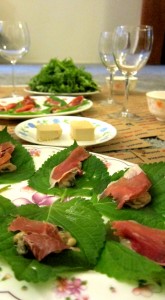
Early September. Monday night. An adorable meal that combines various elements of two Far Eastern cuisines. The parts harmonize, the mixture represents a cuisine of its own: the kind that you can only find in a home kitchen and enjoy with friends in the living room. We sit on the floor, we share twelve courses plus some, we listen to a record of traditional Vietnamese instrumental, we drink chrysanthemum tea in wine glasses. We talk fooding. We feel luxury, “like the wealthy landlords of the old days” as Dang put it. 🙂 A dinner with Oanh and Dang, the Rau Om lady and man, is fine dining without the frilly designed plates, the crisp white napkins, and the pompous lighting. Each of the twelve courses has just enough twists to wow us while retaining enough familiarity to comfort us. But what I like the most about Rau Om creations is the way Oanh and Dang use one country’s familiar ingredients in the other country’s familiar dish, surprising (at least) me with the compatibility and similarities between the two cuisines. It’s the fusion of the authentics.
My ladies and gentlemen, the September 5th Japanese-Vietnamese (+ a little Korean) dinner by Hoang-Oanh Nguyen and Linh-Dang Vu-Phan of Rau Om:

On the foreground is No. 1 – Bossam-styled Oyster con Prosciutto: the oyster was low-temp-cooked (read: “semi-cooked”) at 48°C for 20 minutes in bossam (보쌈) broth in a closed jar, rendering a literally melt-in-the-mouth texture while its fishiness is subdued by the tangy sesame leaf and the briny prosciutto.
In the background are two blocks of No. 2 – Tofu Misozuke, tofu wrapped in miso for at least 2 months. It’s creamy, briny, accented with a herbal afterthought. It’s cheese, but vegan, and better than cheese because the taste evolves in your mouth. We were also introduced to Rau Om’s experimental Kombu Tofu Misozuke, tofu misozuke wrapped in miso and kelp for a less salty but more aged taste.
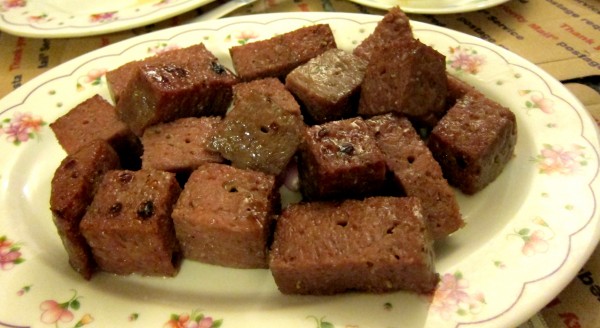
No. 3 – Grilled Lamb Nem. I’ve tried Rau Om beef nem before, fresh and fried, and this lamb version sings a better tune for me. The texture is smooth (they use less pork skin here), grilling keeps them moist, both the lamb scent and the sourness of cured meat are subdominant.
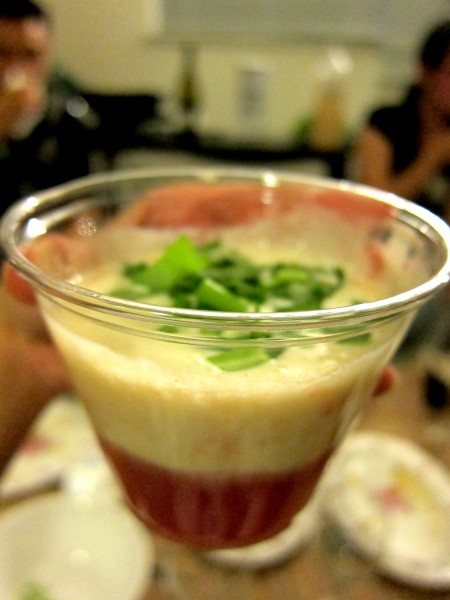
The intermezzo No. 4 – Chilled Tomato Soup topped with Yuba Cream. The frothy soy based cream makes all the fireworks. This soup is the epitome of refreshment. I wanted more.
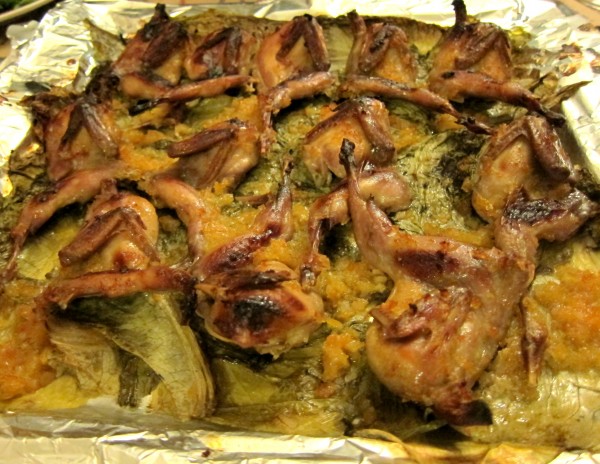
No. 5 – Salted Kumquat Quail, grilled on a bed of lettuce to keep it juicy. The kumquat scent so subtly infuses the bird that all we can feel is a clean herbal flavor, not salty, not fatty, just l(r)ight.
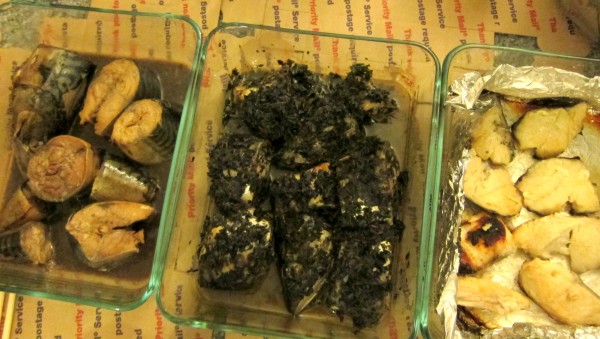
From right to left, because we’re going Japanese, No. 6, 7, and 8 – Sake Kasu Grilled Cod, Mackerel braised with Green Tea Leaves, and Mugicha Mackerel (mackerel braised in barley tea). The braised mackerels, minus the tea, are done in the traditional Vietnamese way (cá kho) with coconut water, sugar and fish sauce. The green tea leaves add a sharp crunch for textural contrast, and once again, the herbal touch dominates the tastes. Personally, I have a soft spot for a lot of coconut water and sugar in a braised dish, but that might prevent the tea from shining through in this case, and at least one of us ranked the braised mackerels top of the list, so Oanh and Dang must be on the right track. 🙂 Tea aside, the fish also got served with the best pickle ever: green cantaloupe in a mild chilipepper and vinegar sauce. The pickle zest makes the sweetest pair with the mugicha mackerel plumpness.

No. 9 – Tofu Misozuke Duck: a twist on the Vietnamese lẩu vịt nấu chao (duck hotpot with fermented tofu), where the chao (fermented tofu with rice wine and salt) is replaced by the tofu misozuke, which is less salty and biting than chao but still as rich. I love the chrysanthemum greens (tần ô or cải cúc) soaked in this thick sauce.

No. 10 – Sous-vide Chao Duck: this time the duck is marinated with chao and cooked sous-vide until pink, then quickly pan-fried for a charred skin. (Side note: The Western palates are accustomed to treating duck breast like steak, but the Vietnamese never eat duck anything less than well done.) Biting into these succulent thighs and legs is like falling onto a giant bed of pillows, y’know wadda mean? 😀
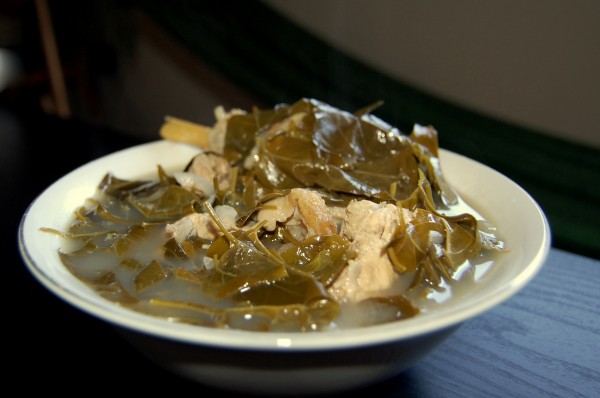
No. 11 – La Giang Sour Soup with chicken (Picture courtesy of Rau Om). Lá giang is the leaf of the Aganonerion polymorphum plant, which has a gentle sourness (as opposed to the piercing sourness of tamarind or dracontomelon (sấu) that is typically used in the Vietnamese canh chua). Ending the meaty main courses with a refreshing sour soup is brilliant, and this simple bi-gredient sour soup is pure genius.

No. 12 – Black Amazake served warm: Rau Om signature Japanese dessert made from Vietnamese black sticky rice (nếp than). The sweetness and the fragrant come directly from the cooked rice, no sugar is added, no grated ginger for flavor, a couple of dried longans garnish the amazake for texture. By itself, the amazake has a smooth porridge-like consistency dappled with the occasional stiffened rice bits.
We pair the meal with chilled sikhye (식혜) and red wine; for the postlude come fresh jujube and lychee to accompany whole chrysanthemum tea and homemade salted kumquat drink. How could we go home when such goodness keeps on flowing?
On one hand, I can’t wait for the day Oanh opens her first restaurant and I’ll get her autograph. On the other hand, I won’t be able to enjoy these relaxing dinners with Oanh when she’s busy with a restaurant. The selfish Mai feels torn. 🙂
——————————————————-
For detailed recipes, visit the Rau Om blog.
——————————————————-
This post is our contribution to the September Edition of Delicious Vietnam, hosted by Phuoc from Phuoc ‘n Delicious. 🙂
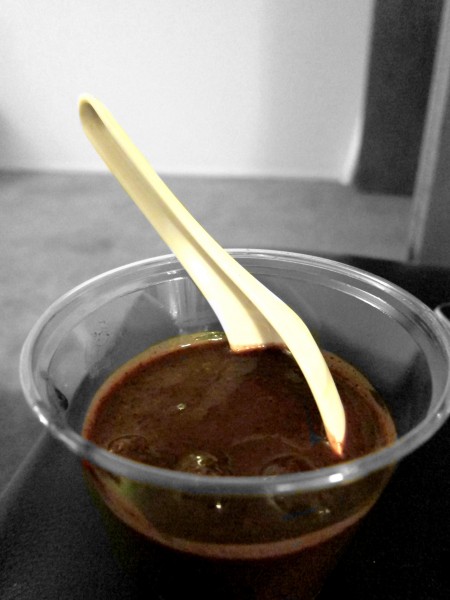
Leave a Reply